Editor’s note: This cautionary tale comes from Rob Siegel, author and columnist for Hagerty Media in the US. If you use a car cover outdoors, it is worth reading on. James Mills
Back in the spring, when I was transitioning between my old rented garage spaces in Fitchburg, Massachusetts, and my newly-found warehouse space about an hour away in Monson, I briefly brought all the cars home, stuffed the rust-prone ones into the garage, and left the others covered in the driveway for a few weeks. At one point, I needed to do work on one of the outside cars, so I brought it into the garage, which necessitated moving my 1974 Lotus Europa Twin Cam Special outside.
Even though the Lotus is a fibreglass-bodied car, the idea of those Lucas electrical components sitting in the rain gave me the willies, so I bought a semi-custom cover for the car. I wrote piece about it, in which I explained that covering a car outdoors is never going to hold a candle to storing it indoors. I even showed some photos of cars I’ve owned, where long-term outdoor storage under a cover or tarp damaged the paint by rubbing or simply by prolonged contact. Sometimes, however, circumstances force our hand, and we just do the best we can.

The Lotus-gets-kicked-outside situation repeated itself in early August. The driver’s-side window on my 1999 BMW M Coupé had been problematic for some time, and it finally quit working entirely with the window (of course) halfway down. And, after a long dry spell in Boston, rain was (of course) forecast for that evening, so the car needed to come into the garage. Rather than assume the problem was the window regulator and then buying one and hoping I was right, I wanted to pull things apart and properly diagnose the cause of the failure before purchasing anything. This meant that the M Coupé would be in the garage for more than a quick sleepover, which also meant that one of the three keep-dry cars would be outside more than just overnight. The logical choice was, again, the fibreglass-bodied Lotus.
So I pulled the car out of the garage, parked it in the driveway, and slid the cover on. As I wrote previously, because the cover is semi-custom and not custom, it’s not a snug fit, but the elastics tucked the front and back of the cover under the nose and tail nicely, so I was confident it would stay in place in the rain and wind.
It’s been a hot dry summer here in Boston, with stretches when the temperatures tickled the 100-degree (38C) mark. Despite the inconvenient timing of the failure of the window mechanism on the M Coupé, the rain was, in fact, welcomed. I didn’t really give a moment’s thought to the stew that could be cooked under the lid of a car cover, with old paint, high heat, and moisture. Why would I? This was what I bought the cover for. Why wouldn’t I put it on the car?
The cover went onto the Lotus on a Thursday night. It rained that evening. The cover sat on the car, in near-100-degree temperatures, on Friday and Saturday. We’re talking two days.
On Sunday morning, I went outside to pull the cover off, and I remember seeing that a fair amount of water had pooled on the Europa’s flat “bread fan” deck lid. I thought that that meant that the waterproof cover was doing its job.
Imagine my surprise and horror when I removed it and found this:
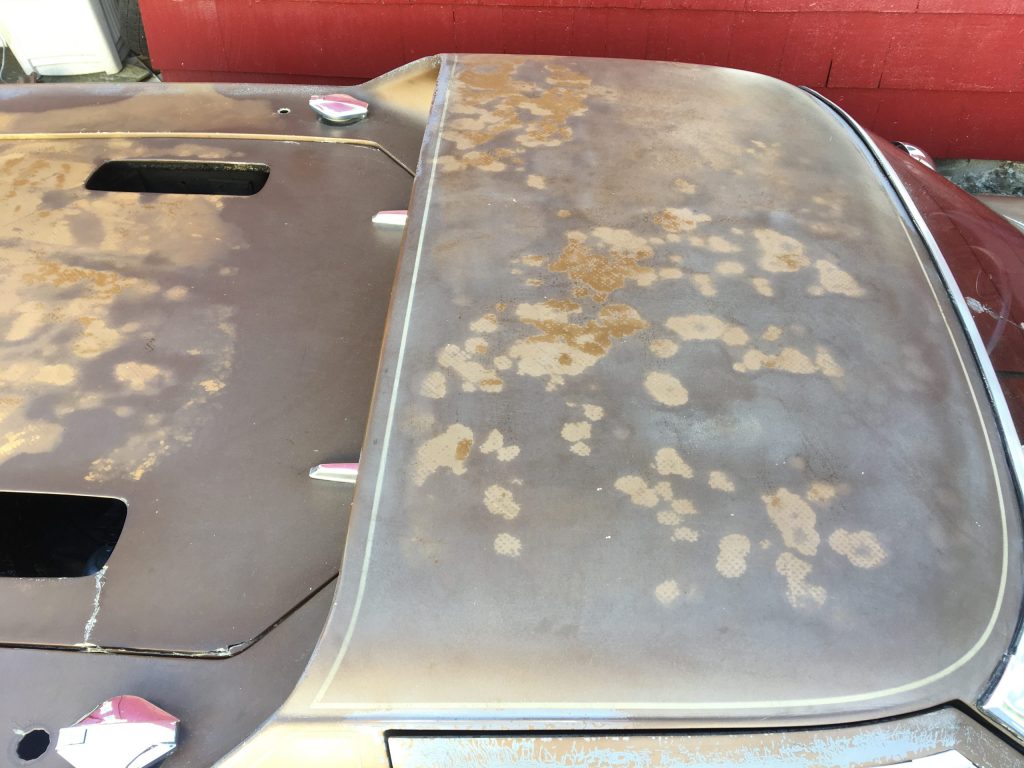
My first reaction was one of cognitive disconnect – I literally didn’t understand what I was seeing. Had something leaked onto the car? My wife has tomato pots on the garage roof, and the car was in the driveway near the garage door. With all the rain, had one of the pots leaked dirt that got blown onto the cover and minerals or fertiliser or something leeched through it? Would the discolouration just wipe off? Unfortunately, none of that was the case. Whatever it was, it wasn’t residue.
Then I wondered if somehow paint had stuck to the underside of the cover and peeled off. I partially unrolled the cover, looked at the cloth lining, and found that it was paint-free.
Slowly, the picture formed. The Lotus’ paint itself was discoloured. Badly. Permanently.
What the hell?
Not being sure what else to do, I left the car in the hot sun for the rest of the day, hoping that maybe the discolouration would bake off. As the paint heated up, a small amount of the cloudiness of the damage seemed to lift, but if anything, it just made it look worse, as the edges of the affected areas became more defined.
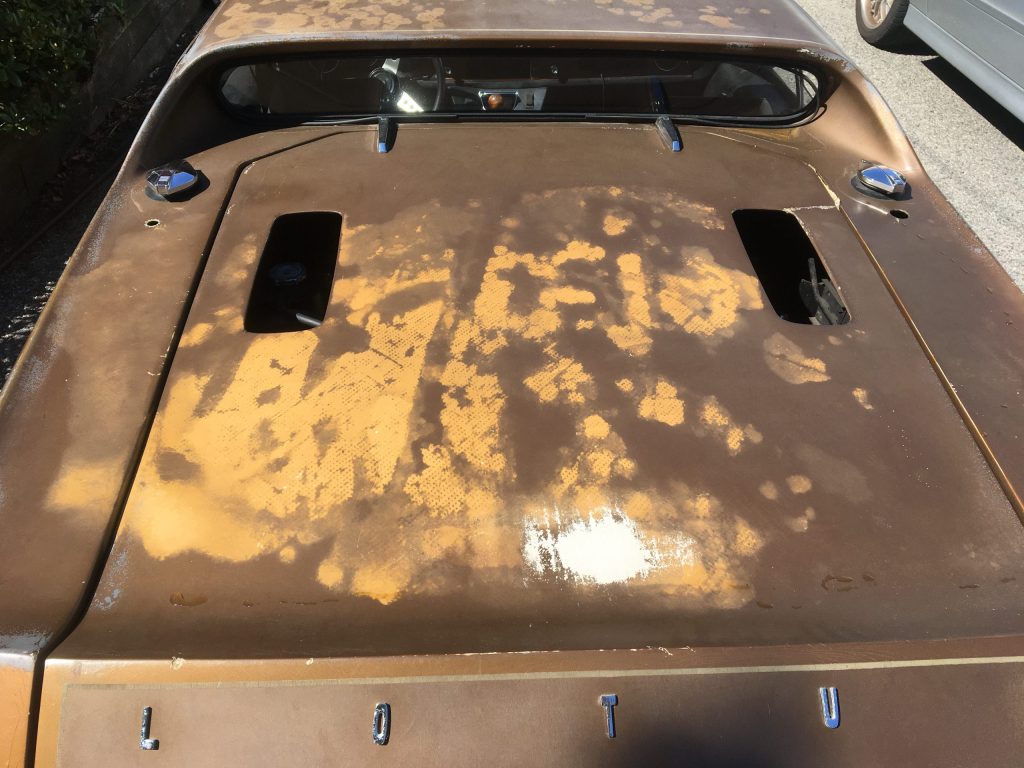
It appeared that what had happened was that some of the standing water on the flat horizontal surfaces of the engine cover and bonnet had soaked through the cover. The car cover trapped the water against the old dry porous paint, and the high heat had done something akin to boiling it in place, creating the discolouration.
I was livid. While I like cars with patina, it should be akin to the lines on my 64-year-old face, not a fat ugly scar from having done something stupid. My Europa is a survivor. It was stored in a container from 1979 to the early 2010s, then was purchased by a fellow who used it as a conversation piece in the lobby of his European car repair shop. I bought it, dead and sight-unseen, in 2013, and had it trucked here from Chicago. When it arrived, I found that it was rougher than it looked in the photos – it looked like a cover or a tarp had worn the paint off sections of the bonnet, engine cover, door tops, and the corners and edges of the car – but it had a great original vibe to it. I rolled it into my garage and yanked out the drivetrain in one feverish weekend, but then six years elapsed before I got the engine back in. During that time, the car sat uncovered in my garage, boxes were eventually piled on top of it (I know – stupid, right?), and dust, grit, and grime killed much of the shine. But still, the car’s vibe was unmistakably that of an intact survivor. I’m well aware that the “rat rod” look – intentionally building cars that look distressed, often with clear-coated “relic’d” finishes sitting atop $2000 wheels – is a thing, but it’s not my thing. The idea that I’d caused this step-change in the car’s appearance because I covered the car outdoors was heartbreaking.
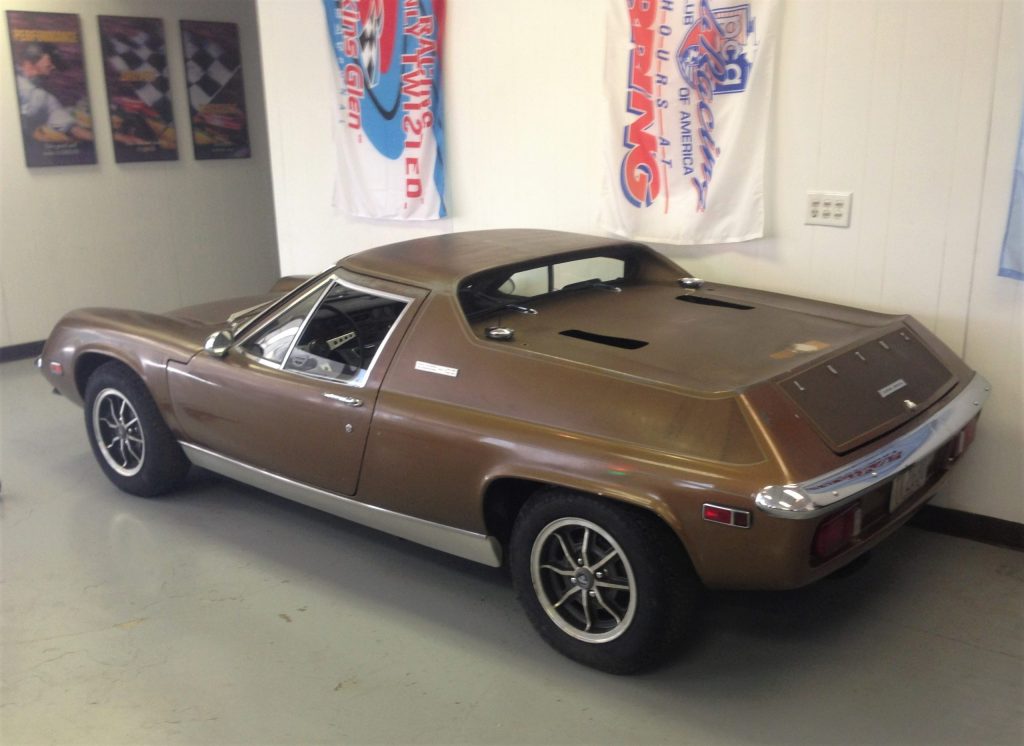
Before I go further, let me state very clearly that I don’t blame the specific brand or model of cover for what happened. I think it could have happened with any cover and that it was a product of the old cracked dry porous paint, the trapped moisture, and the high heat.
I posted photos of the damage to my Facebook page with the explicit admonition “Please don’t use that worn-out adage ‘That’ll buff out,’ as there’s not enough paint on this car to buff.” The comments poured in. They ranged from “Just repaint the car” (don’t you love how easily people throw around money that isn’t theirs?) to recommendations that I use rubbing alcohol to draw out the moisture in the paint, to a musing from a high school friend of mine about whether household cleaners might work. I rolled my eyes at that one and thought, “That’s dumb.”
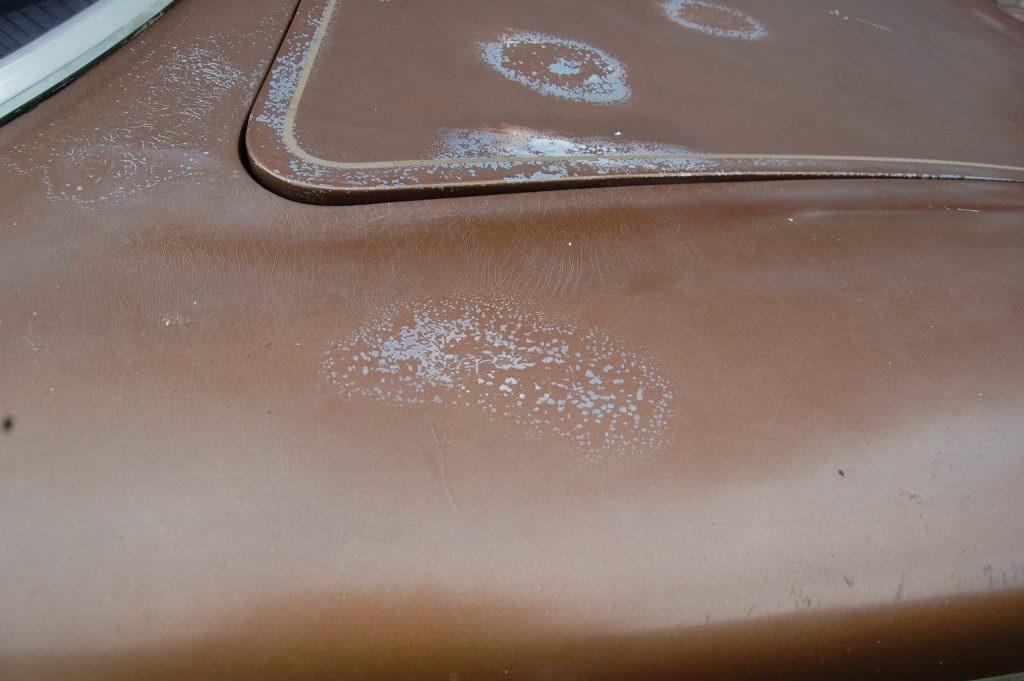
One of the issues in a situation like this is that you’re faced with taking a car that already has a high level of wear and patina, and it’s nearly impossible to repair a damaged area so it looks more or less like it did before. In addition to the paint damage, the Lotus’ engine cover has several large cracks in it, so I suppose it might be tempting to find a shop that could repair and repaint just that one easily removable panel. That, of course, would make it stand out like a sore thumb against the rest of the survivor body. That didn’t strike me as a good solution unless I wanted to slide all the way down the slippery slope of body restoration, and that would not be cheap.
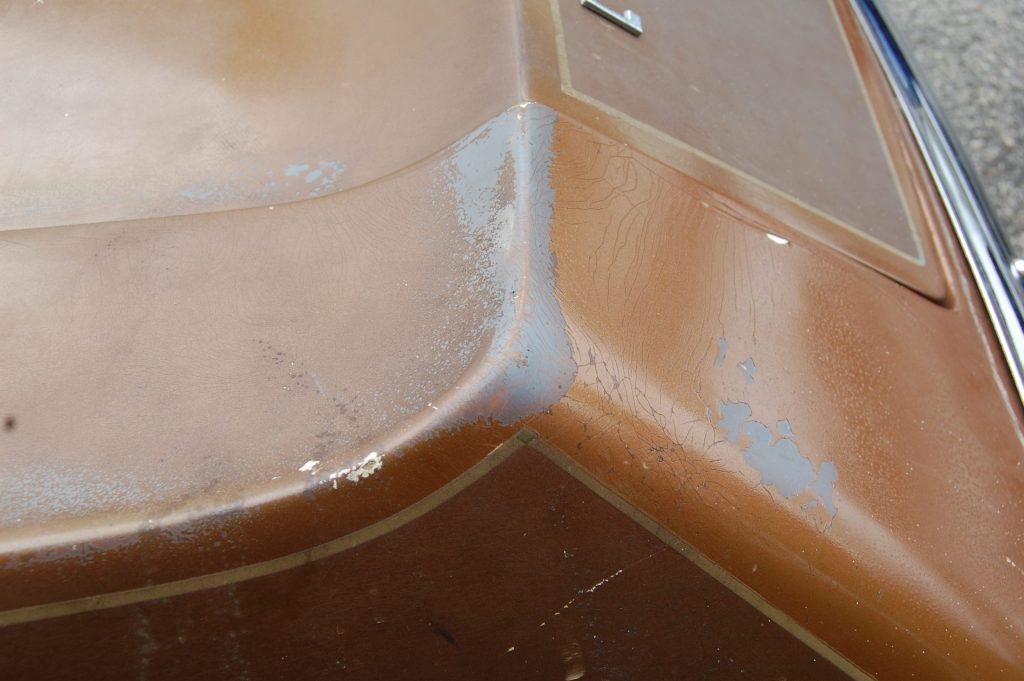
I stared at and poked and prodded the damaged panels for an hour, trying to wrap my head around what, if anything, could be done about it. Intellectually I thought that, going forward, the discolouration could be part of the car’s story, but emotionally, my reaction was, “Yeah, a stupid part of its story, and it was my stupidity,” even though throwing a cover over a car before it sits in the rain is hardly, on its face, a stupid action.
But then I discovered that the yellow discolouration on the deck lid had an almost chalky consistency to it that I could scrape through with my fingernail. And there appeared to be dark paint beneath it. Despite my “don’t tell me to buff it out” admonition, I began to wonder if I could do exactly that – use some sort of abrasive to remove the damaged paint and expose the good stuff underneath.
Now, I am not someone who engages in “paint correction.” Even the term rubs me the wrong way (pun intended). I don’t go to concourses or obsess about scratches or swirl marks on my cars. I wash the pretty and shiny ones when they’re dirty, but basically leave it at that. I think that I can count on one hand the number of times I’ve waxed a car. However, I do own a Porter Cable random orbital polisher I bought a while back to revive badly oxidised paint on a black BMW 2002 that I’d bought. I dug it out of a bin in the garage, found an old bottle of Meguiar’s all-in-one compound, and was prepared to give it a whirl when I found that the foam pads for the polisher were filthy. I washed them, and while I was waiting for them to dry, I hand-rubbed the Meguiar’s on one of the Lotus’ yellow spots using a microfibre towel. It had very little effect. I ran down to the local AutoZone, threw seven bucks at a bottle of Turtle Wax Heavy Duty compound, and tried hand-rubbing that. It began to cut through the yellow chalk, but when I tried using it on a foam pad on the orbital polisher, the effect was minimal. A rotary polisher might have done a better job, but I don’t own one.
Then, for some reason, I remembered my high school friend’s question about whether some household cleaning product might be effective – the one I’d filed away as “dumb.” I mean, I have been known to use oven cleaner to remove decades of caked-on grime from a transmission. My mind suddenly hyper-linked from oven cleaner to Mr. Muscle to the Mr. Clean to the “Mr. Clean Magic Eraser” product my wife has raved about for years. The Magic Eraser is basically a sponge that exudes abrasive melamine foam, and I have to admit that when I’ve used it, I’ve been very impressed. I did a quick online search for “using Magic Eraser on car paint.” The short answer appeared to be “Don’t, unless you’re using it to remove some paint that wound up on the bumper because you clipped your white mailbox post turning into your driveway.” The longer answer was that while it will probably remove whatever inadvertently transferred paint or tar or tyre tread scuff you’re trying to get off, it’ll probably scratch the hell out of the paint, and you’ll need to polish out the scratches afterward.
Having little to lose, though, is great motivation. I wetted a Magic Eraser and had at some of the yellow chalky sections of the deck lid.
Wow.
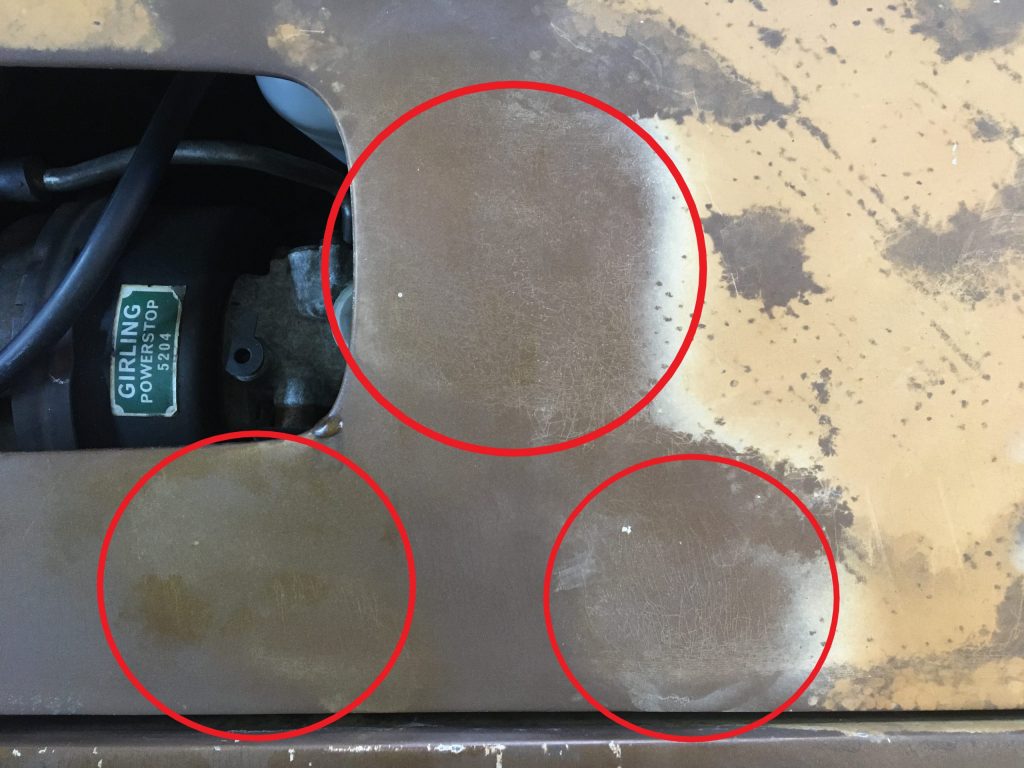
I was elated. I thought that, with a few hours and some elbow grease, this damage will be just a memory.
It was, of course, more complicated than that. In the first place, the Magic Eraser, like any abrasive, removes paint, and with the dry fragile nature of the paint on the Lotus, I had to be very careful not to rub through to the fibreglass. Second, the area that you rub is always bigger than the damaged area, and rubbing changes the look of the paint, so, like sanding superficial rust spots, you take a small, damaged section, and by fixing it wind up making it bigger. Third, as the Magic Eraser worked its melamine foam into the chalky yellow coating, it turned it into a yellow liquid, and as you can see in the photo above, that yellow liquid found its way into the cracked paint. I did have some luck in using rubbing alcohol on a folded paper towel to draw the yellow out and soak it up. In places this worked so well that I switched from the Magic Eraser to using only rubbing alcohol, but like the Eraser, the rubbing alcohol changed the colour of the paint, and at times removed paint surprisingly quickly.
Still, in a few hours, I’d removed nearly all of the yellow chalk from the deck lid and knocked the appearance of the circular artefacts on the roof way back. I then tried a pass with the orbital polisher in the hopes that it would make the paint look more uniform. While it did impart a bit of shine, it didn’t really take enough paint off to make the treated and untreated areas look the same. I ordered some well-reviewed Sonax MaxCut heavy cutting compound as well as a new pad for the polisher, but there’s so little paint left on the trunk lid that I’m a little afraid to use it.
Still, I took this:
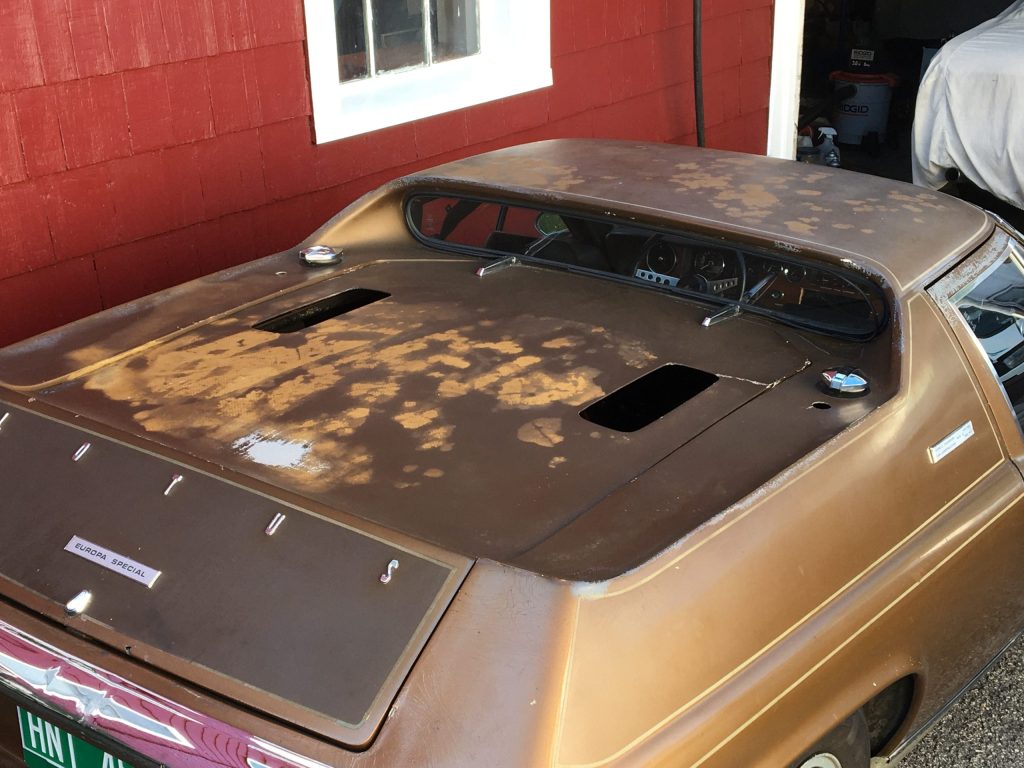
And turned it into this:
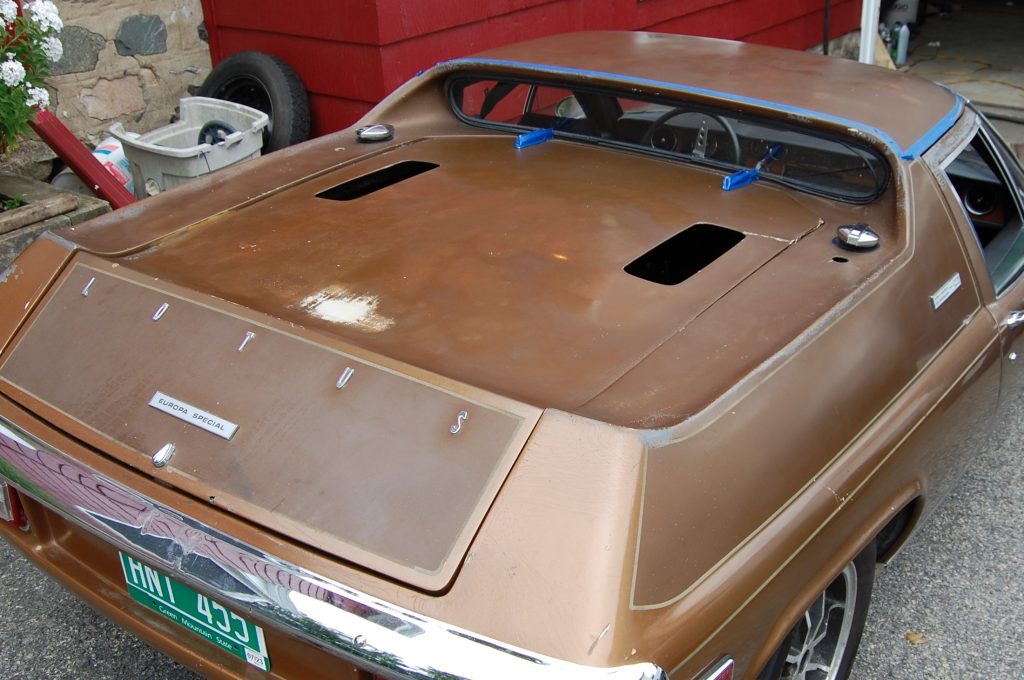
After “the cover incident,” when I looked at the Lotus, I felt like a stake had been driven through my chest. Now, the slightly shiny/slightly blotchy appearance of the roof and engine cover are more or less in harmony with the car as a whole. I may play around with the polisher a bit more – I may even try to put some shine on the rest of the car – but bottom line, I can live with it. Hell, it’s more than that; I rescued it from both of us having to live with the ignominy of the scars caused by covering it. There may come a winter when I feel that I have so little to do that I go down the rabbit hole of pulling the fibreglass body off the frame and sending it out for refinishing, but for now, this is all it needs to be.
Whew!
Now, every time I see a car under a cover in a driveway, I feel like stopping, knocking on the door, grabbing the owner by the shoulders, shaking him or her, and saying “What are you doing? Do you know what happened to my Lotus in just two days under a car cover?”
***
Rob Siegel’s latest book, The Best of the Hack MechanicTM: 35 years of hacks, kluges, and assorted automotive mayhem, is available on Amazon. His other seven books are available here, or you can order personally inscribed copies through his website, www.robsiegel.com.
Read more
Our Classics: 1982 Lotus Esprit S3 | Pray for my respray
Testing a tyre to the limit… unintentionally
Reviewed & Rated: The best driveway cleaners










That’s a long article about a car that needed a respray still being a car that needs a respray.
Its a fine line between patina and neglect. Colin Chapman was fastidious about appearance and would have hated seeing such a beautiful car wanting for a lick of paint. Hopefully one day it will be back to its former glory.